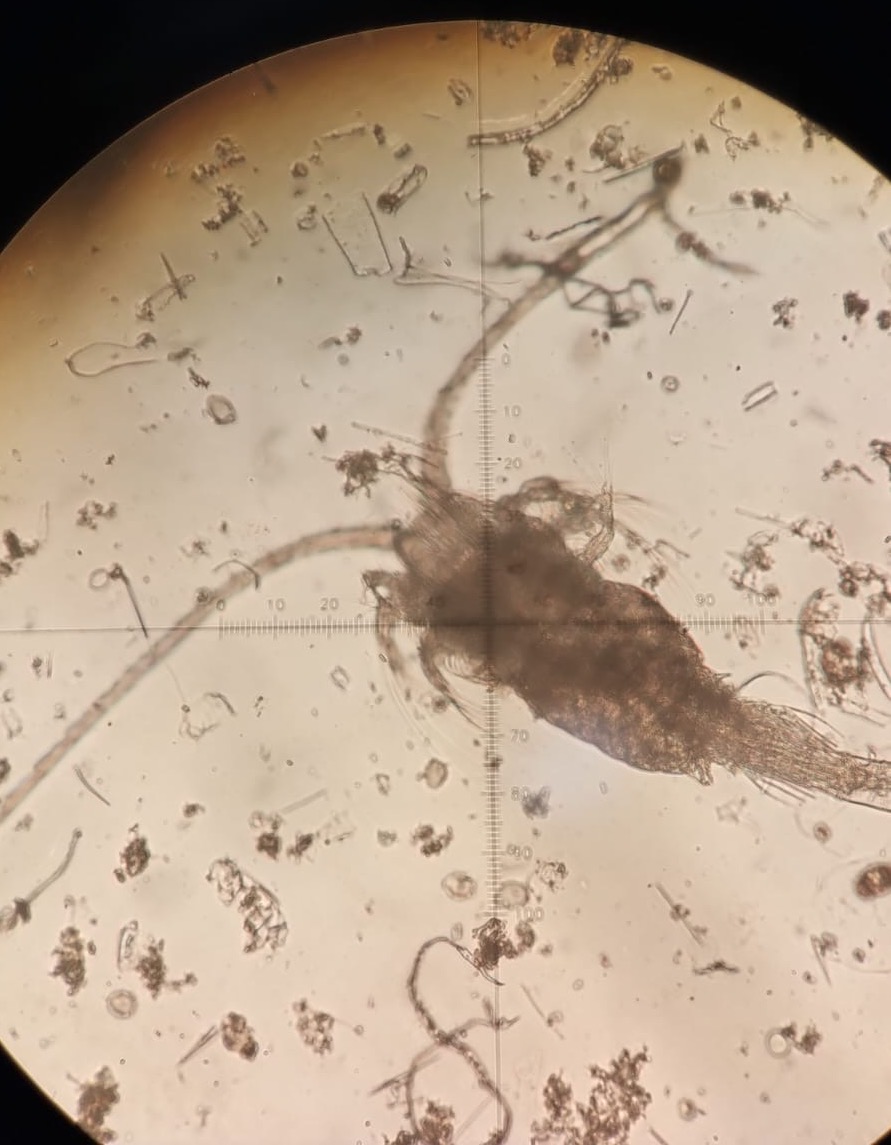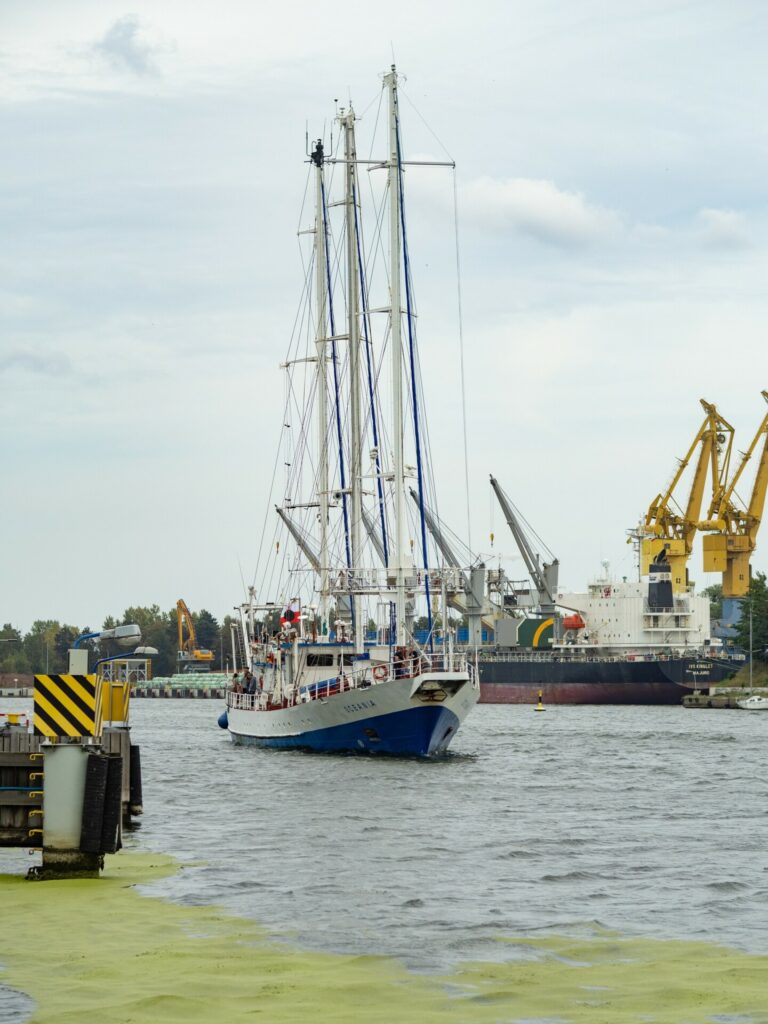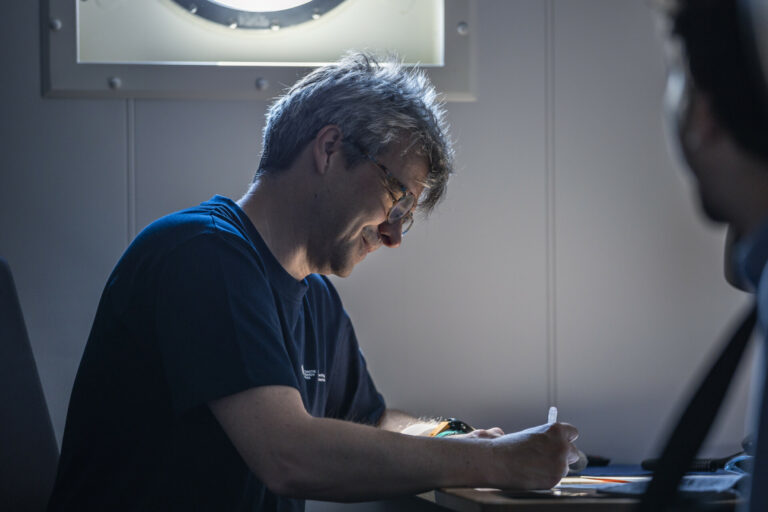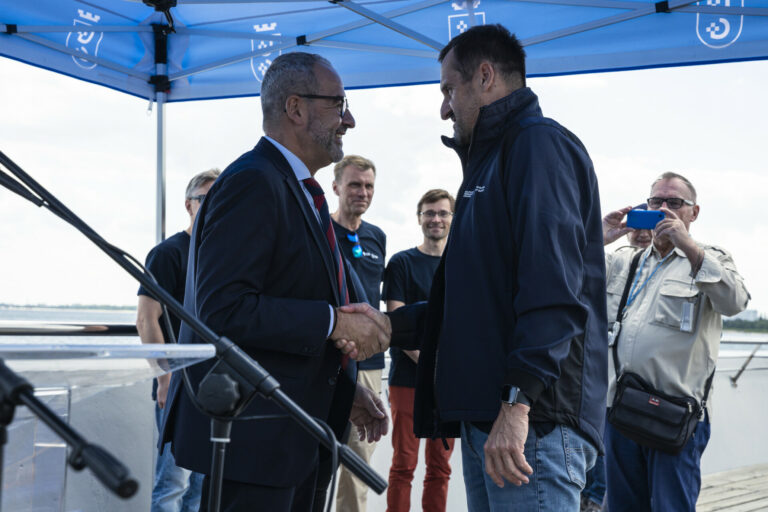The tenth day of the expedition, we sailed from Kiel five days ago and have only enjoyed calm weather for brief moments since. We haven’t encountered a really stormy one either, but the winds are blowing evenly all the time, and now we’ve also had to duck behind a rocky island below Stavanger – an old Viking settlement and now the oil capital of Norway – for a few hours so that the scientific team can carry out their research without risking dislodging themselves and their equipment from the deck.
You ask: what team? You ask: what kind of research?
The team is international, of course, and among the dozen or so scientists there are mainly people from the Faculty of Oceanography and Geography at the University of Gdańsk, but as this is a joint project by a European consortium of SEA-EU universities, people from Italy, Spain and Portugal are also playing board games with us.
You ask: which board games? You ask: what project?
We will talk about board games in the episode ‘Social and emotional life’.
The main project, in a nutshell, is to study where the Baltic water goes and what it tells us. Because yes, this water does travel. The salty ocean presses down on the bottom into our sea, causing the sweeter Baltic water to ‘spill’ over the surface and travel to… – well, that’s the question: where does this water travel to, and with it the plants, animals and pollutants. Is it just to the Danish straits? Or maybe to the North Sea? Or as far as the Arctic, beyond the Arctic Circle? And what is the result?
You ask: how can this be investigated? After all, there is no water with a flag saying ‘made in Baltic’.
In short: with the help of a bucket.
A bucket on a string is an oceanographer’s basic research tool. It is used to draw water from the ocean and look at it. Other techniques are de facto developments of this concept.
To draw water just from the surface and study the ocean’s epidermis of magical properties, a sieve is used, reminiscent of gold prospecting equipment.
To draw water from different depths, remote opening and closing cylinders are lowered on a rope.
To catch what lives in the water – plankton, creatures, microplastics – they use nets that release water, trapping other finds.
Of course, the ocean is also studied with sonar, microphones, cameras, sensors measuring temperature, salinity, light and a hundred other parameters, but the essence of oceanographic research seems to be the idea: hey, let’s take a bucket of water and see what we find there.
You ask: what will we find there? Apart from fish, rubbish and cyanobacteria?
I was reading recently about how powerful and important the emotion of awe is for us, which we sometimes experience when we are in contact with nature. It is a peculiar feeling when we shrink back, seeing how small and insignificant we are in the face of the vastness and complexity of the world. But, at the same time, we are filled with satisfaction and power because we are part of this uniqueness, able to see it, to marvel at it, to be moved by it. This emotion gives us strength to live, calms us down, shows us our place, cures us, if only for a moment, of our egoism, arrogance and mania for greatness.
This is why I understand oceanographers, because the sea amazes on every scale. Whether you are looking at it from space, from the deck of a ship in the middle of the sea, from a sailboat, from the beach. Whether you’re watching a sunset on a calm day or stormy waves under a sinister sky – it’s always just as awe-inspiring. So why not look closer? How about looking deeper?
As we look a little closer, into the containers and beakers in the Oceanograf’s lab, the concentrated ocean looks like a spinach smoothie. In the plankton jungle, a multitude of microscopic life swims, jumps and flashes blue lights.
If you look even closer, into the eyepiece of a microscope, you can see a whole universe of organisms that are sometimes plants, sometimes animals, and sometimes it depends, because they can be both.
They laugh at me for jumping away from the microscope when a sea cockroach suddenly flew between the plants and microplastic particles, chased by a huge bloodthirsty monster almost half a millimetre long.
So much life in one drop of ocean.
Inventing more gods, daydreaming about extraterrestrial life – it all seems so terribly silly, when within us and around us at our fingertips we have more magnificence than we can comprehend.
Think about that.
And think about the fact that every time you gulp some water while playing in the sea, you’re ingesting a handful of bugs that look like monsters from The Witcher. Enjoy.
R/V Oceanograf
BaltArctic Research Cruise, Day 10
12 June 2024
Wiadro i kropla
Wieje równo • Wielka wyprawa małego Bałtyku • Wiaderko naukowe • Lekarstwo na manię wielkości • Ocean wygląda jak szpinakowe smoothie • Łyk potworów
Dziesiąty dzień wyprawy, pięć dni temu wypłynęliśmy z Kilonii i od tamtej pory tylko przez krótkie chwile cieszyliśmy się spokojną pogodą. Nie spotkała nas też naprawdę sztormowa, ale wieje cały czas równo, teraz też musieliśmy się schować na kilka godzin za skalistą wyspą pod Stavanger – starą osadą Wikingów, a dziś stolicą norweskiej ropy – żeby ekipa naukowa mogła przeprowadzić swoje badania, nie ryzykując zwiania siebie i sprzętu z pokładu.
Pytacie: jaka ekipa? Pytacie: jakie badania?
Ekipa międzynarodowa, wśród kilkunastu naukowczyń i naukowców są oczywiście głównie ludzie z Wydziału Oceanografii i Geografii Uniwersytetu Gdańskiego, ale że to projekt wspólny europejskiego konsorcjum uniwersytetów nadmorskich SEA-EU, grają z nami w planszówki też ludzie z Włoch, Hiszpanii i Portugalii.
Pytacie: jakie planszówki? Pytacie: jaki projekt?
O planszówkach będzie w odcinku „Życie towarzyskie i uczuciowe”.
Główny projekt, w skrócie, polega na badaniu, dokąd dociera bałtycka woda i co z tego wynika. Ponieważ tak, woda ta podróżuje. Słony ocean wciska się po dnie do naszego morza, sprawiając że słodsza bałtycka woda „wylewa się” po powierzchni i wędruje do… – no właśnie to jest pytanie: dokąd ta woda wędruje, a razem z nią roślinki, zwierzątka i zanieczyszczonka. Czy tylko do cieśnin duńskich? A może do Morza Północnego? A może aż do Arktyki, za koło podbiegunowe? I co z tego wynika?
Pytacie: jak to zbadać? Nie ma przecież woda chorągiewki z napisem „made in Baltic”.
W skrócie: za pomocą wiadra.
Wiaderko oceaniczne na sznurku jest podstawowym narzędziem badawczym oceanografa. Służącym do tego, żeby zaczerpnąć wody z oceanu i się jej przyjrzeć. Inne techniki są de facto rozwinięciem tego konceptu.
Żeby zaczerpnąć wody tylko z samej powierzchni i zbadać naskórek oceanu o magicznych właściwościach, używa się sitka, przypominającego sprzęt do poszukiwania złota.
Żeby zaczerpnąć wody z różnych głębokości, opuszcza się na linie zdalnie otwierane i zamykane butle.
Żeby nałapać tego, co w wodzie mieszka – plankton, żyjątka, mikroplastik – korzysta się z siatek, które wypuszczają wodę, zatrzymując inne znaleziska.
Oczywiście ocean bada się też echosondą, mikrofonami, kamerami, czujnikami temperatury, zasolenia, światła i stu innych parametrów, ale istotą badań oceanograficznych zdaje się być pomysł: hej, zaczerpnijmy wody wiaderkiem i zobaczmy, co tam znajdziemy.
Pytacie: co tam znajdziemy? Oprócz ryb, śmieci i sinic?
Czytałem ostatnio, jak potężna i ważna dla nas jest emocja zachwytu, której doświadczamy czasami w kontakcie z naturą. To specyficzne uczucie, kiedy kurczymy się, widząc jak mali i nieważni jesteśmy wobec ogromu i złożoności świata. Ale jednocześnie wypełnia nas satysfakcja i potęga, bo jesteśmy częścią tej niezwykłości, potrafimy ją dostrzec, zachwycić się, wzruszyć. Ta emocja daje siłę do życia, uspokaja, pokazuje nam nasze miejsce, choć na chwilę leczy z egoizmu, arogancji i manii wielkości.
Dlatego rozumiem oceanografów, ponieważ morze zachwyca w każdej skali. Niezależnie od tego, czy się nań patrzy z kosmosu, z pokładu statku na środku morza, z żaglówki, z plaży. Bez względu na to, czy oglądamy zachód słońca w spokojny dzień czy sztormowe fale pod sinym niebem – zawsze jest to tak samo zachwycające. Więc może spojrzeć bliżej? Może spojrzeć głębiej?
Jak spojrzymy trochę bliżej, w pojemniki i zlewki w laboratorium Oceanografu, zagęszczony ocean wygląda jak szpinakowe smoothie. W planktonowej dżungli mnogość mikroskopijnego życia pływa, podskakuje i błyska niebieskimi światełkami.
Jak spojrzymy jeszcze bliżej, w okular mikroskopu, zobaczymy cały wszechświat organizmów, które czasami są roślinami, czasami zwierzętami, a czasami to zależy, bo bywają i tym i tym.
Śmieją się ze mnie, że odskoczyłem od mikroskopu, kiedy między roślinkami i drobinkami mikroplastiku nagle przeleciał mi jakiś karaluch, ścigany przez ogromnego krwiożerczego potwora długości nieomalże połowy milimetra.
Tyle życia w jednej kropli oceanu.
Wymyślanie kolejnych bogów, rojenia o życiu pozaziemskim – wszystko to wydaje się tak strasznie głupie, kiedy w nas i wokół nas na wyciągnięcie ręki mamy więcej wspaniałości, niż jesteśmy w stanie pojąć.
Pomyślcie o tym.
Oraz pomyślcie, że za każdym razem, kiedy się zachłyśniecie w czasie zabawy w morzu, to łykacie garść robali o wyglądzie potworów z „Wiedźmina”. Smacznego.
R/V Oceanograf
BaltArctic Research Cruise, Dzień 10
12 czerwca 2024





